With the convenience of online shopping, the way people seek out and buy auto parts has totally changed. Valued at $199 billion by 2032, the automotive ecommerce market is being driven by car owners seeking quick solutions and suppliers looking to improve the efficiency of workflow and sales.
Buying auto parts used to mean sifting through limited inventories and spending time hunting for compatible parts. Today, marketplaces make this a thing of the past, offering buyers fast, reliable tools to find parts while helping suppliers reach more customers.
Backed by Codica’s experience, in this article, we’ll focus on the must-have auto parts marketplace features for your successful market positioning and users’ satisfaction.
Features for buyers
Smart search and easy filtering
Having a powerful search function with intuitive filters is essential for any auto parts marketplace.
Imagine yourself in need of a specific car part: wouldn't it be convenient to locate it quickly with just a few clicks? It turns out that 69% of online shoppers go directly to the search bar when they visit eсommerce websites.
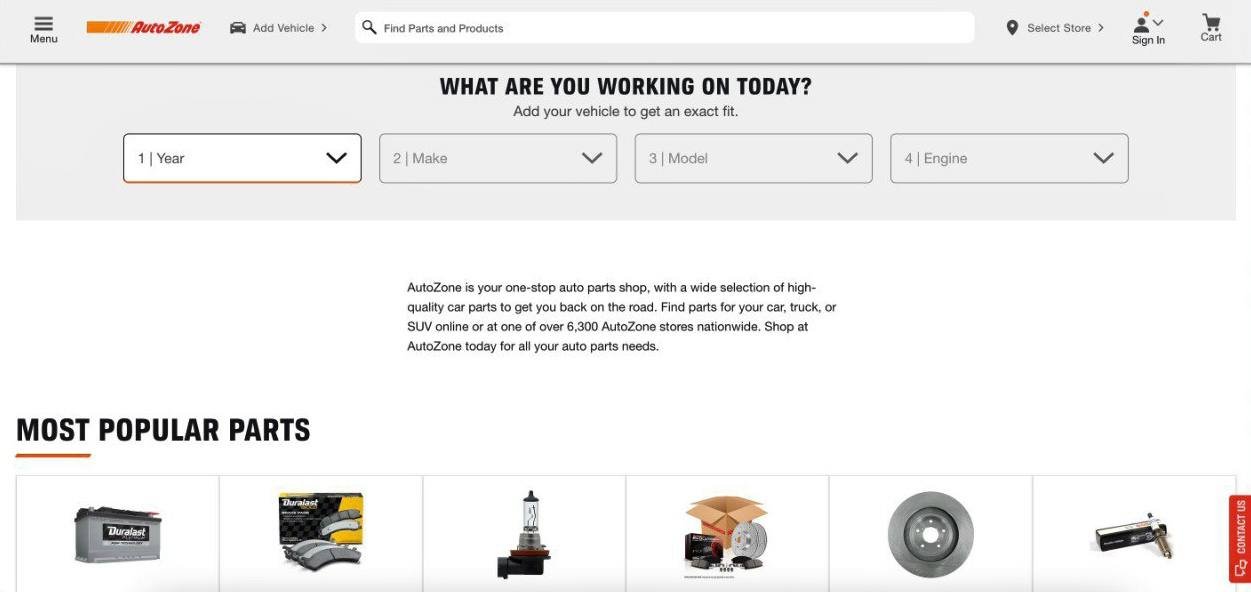
Source: AutoZone
Take AutoZone, for example. This marketplace utilizes an effective auto parts marketplace search function that allows customers to filter results based on the specifications of the item they are shopping for. Customers can quickly find the auto part they need and come back more often.
Detailed product information
The inability to find relevant product information is one of the leading causes of shopping cart abandonment. That's why complete and accurate auto parts description is necessary to help buyers make informed decisions.
Descriptive content should contain items such as:
- Technical specifications: material, ratings, and features.
- Part numbers: unique identifiers to ensure compatibility and simplify searching.
- Dimensions: size information to confirm proper fit.
- Compatibility notes: clarification of which makes and models the part will fit..
- High-quality images: clear images from angles to give customers a comprehensive view.
- Installation guides: step-by-step instructions for those who prefer DIY repairs.
- User reviews: insights from previous customers to build trust and educate potential buyers.
Clear product details reduce the number of returns, additionally giving customers confidence in the marketplace and increasing their trust.
Vehicle compatibility tool
Including a vehicle compatibility tool is a must to help customers easily identify which parts will fit their cars and add a touch of convenience to their buying process.
For maximum efficiency, the tool should have an accessible interface for ease of use and be updated regularly to keep the database up to date with the latest vehicle models. Clearly presented compatibility information on product pages helps customers quickly determine fit.
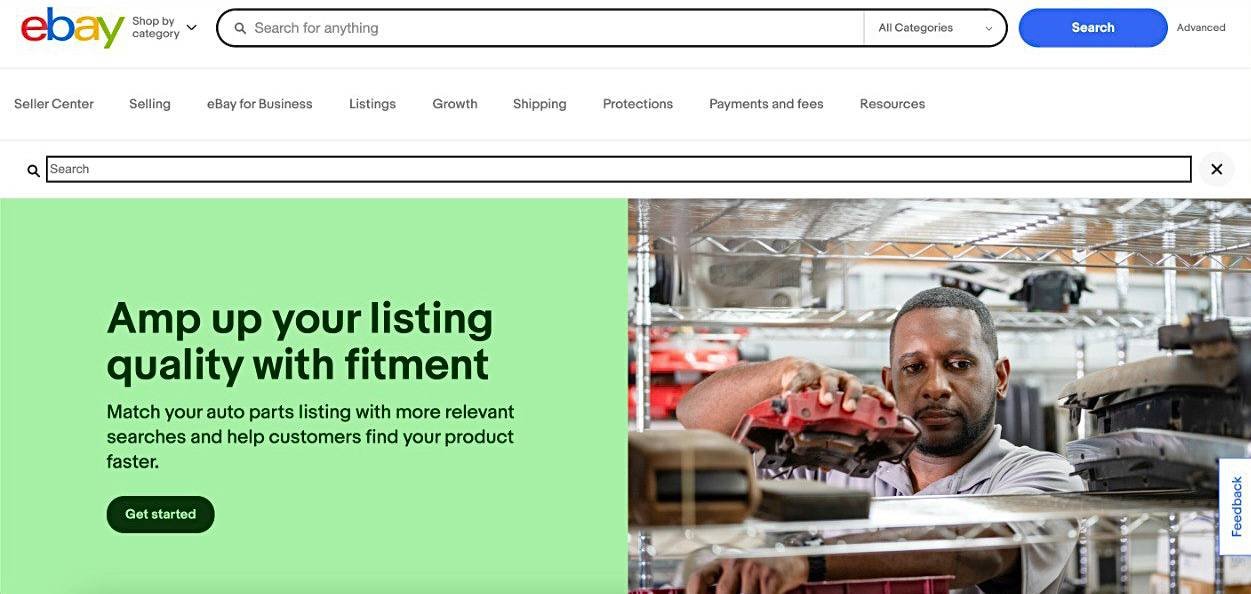
Source: eBay's Fitment Plus
Ultimately, compatibility auto parts checker improves customer satisfaction and increases sales, making this an important tool for any ecommerce marketplace for auto parts.
For instance, eBay's Fitment Plus tool, enables shoppers to get the right parts, contributing to satisfaction, reducing returns, and ultimately boosting the sales of your store.
Wishlist and product comparison tools
Customers usually want to compare products before making a purchase or save items for later. That's why every automotive parts marketplace needs the ability to "wish list" and "compare products" to help shoppers decide and improve user engagement.
Here’s what these features can offer:
- Save for later: users can add preferred items to a wishlist for future reference.
- Price and stock alerts: notify customers of price changes or stock availability to trigger timely purchases.
- Side-by-side: allows users to compare offers based on key factors such as specifications, price, and reviews.
- Informed purchasing: makes it easier to choose between similar items, increasing confidence and reducing shopping basket abandonment.
- Personalized marketing opportunities: use wishlist and comparison data to create targeted promotions and retargeting campaigns.
Just see how user-friendly the cart is at CARiD, perfectly integrating wishlist and comparison tools for auto parts.
The study revealed that 40% of shoppers say their shopping experience would be improved if retailers offered the ability to save an item to a wishlist. That's why the implementation of such tools is more than a matter of convenience: it's an expectation that can have a huge impact on engagement and conversion.
Clear and fair return policies
One of the most powerful factors for customer satisfaction and loyalty is a smooth, hassle-free return process. Indeed, 67% of online shoppers check a company's return policy before making a purchase, which indicates the confidence this builds.
Here’s how to create clear and fair return policies:
- Clear and straightforward policies on what can be returned, within what timeframe, and by what method will prevent misunderstandings or disputes.
- Provide pre-paid shipping labels to make the return process convenient and free for customers.
- Be upfront about any restocking fees or exceptions so that customers know what to expect and aren't taken by surprise.
- Make the process easy to follow, this will help customers feel confident about initiating returns.
A well-articulated return policy makes customers feel comfortable and builds more confidence in choosing your marketplace.
Features for sellers
Support for multiple vendors
Adding multi-vendor functionality allows a marketplace to offer more types of products, which means attracting buyers with more interest in their products.
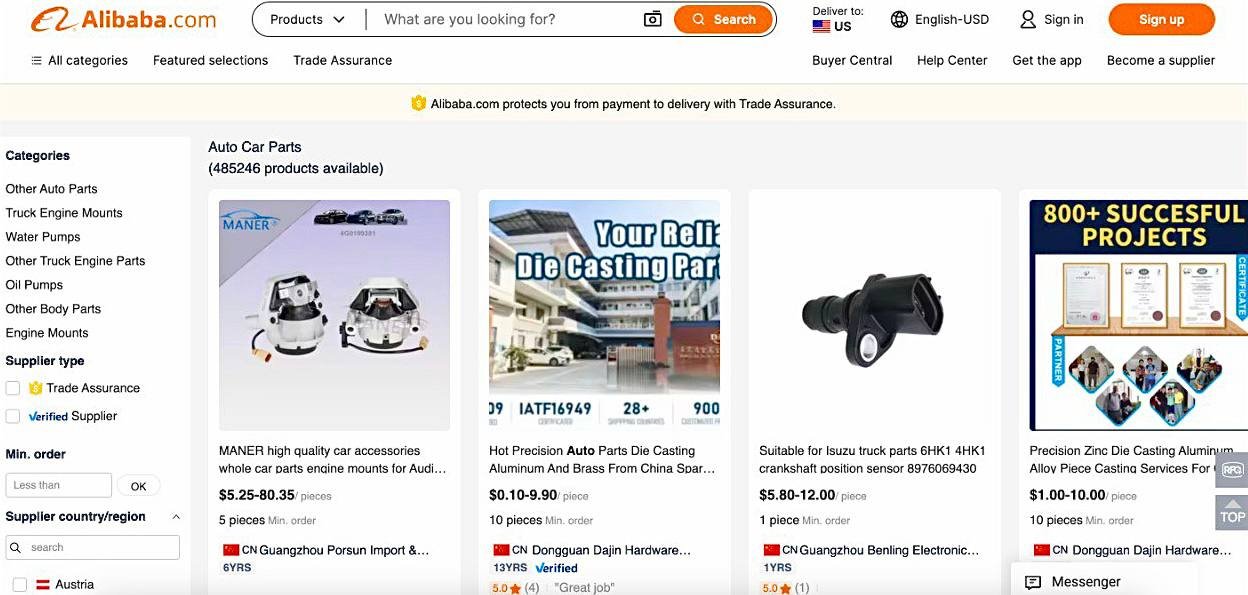
Source: Alibaba
Multi-vendor marketplace tools provide sellers with a dashboard, real-time inventory management for auto parts, and sales tracking capabilities. These not only help your marketplace grow, but also keep it sustainable by providing support for sellers and a variety of choices for buyers.
Here’s what it provides:
- For buyers: a greater variety of products at better prices and improved availability.
- For sellers: the ability to reach a wider audience, more easily manage inventory, and use data-informed insights to increase sales.
For example, Alibaba’s marketplace for auto parts provides extensive choices and real-time management tools for sellers.
Vendor management panels
An automotive parts marketplace will only be successful if suppliers are provided with effective tools that simplify operations and improve performance, making them reliable partners. Giving your suppliers advanced capabilities means more credibility for your marketplace.
Real-time inventory updates
Inventory problems lead to dissatisfied customers and lost sales. Automation and inventory management integrations make sure that sellers are always up to date with stock levels, reducing the possibility of human error.
Solutions to prevent inventory discrepancies:
- Automated synchronization ensures up-to-date stock levels all the time, reducing over-selling and out-of-stock items showing.
- Low-stock alerts enable vendors to restock popular items in advance, avoiding lost opportunities.
- Accurate inventory builds trust among customers, who can confidently shop knowing the parts they need are indeed in stock.
As an example, marketplace AutoZone ensures that vendors keep their inventory accurate to avoid cancellations and provide reliable product availability.
Dashboard for easy management
A well-designed vendor dashboard serves as the command center whereby complex operations are made simple and intuitive. Here is how a dashboard simplifies vendor tasks:
- The vendors can add/update product listings with ease to maintain accurate inventory levels so customers can find the right parts.
- Real-time order tracking allows vendors to manage shipments more effectively, enabling them to fulfill orders faster compared to traditional systems.
- Deep performance metrics provide vendors with actionable insights into the best-selling products, peak sales periods, and areas for improvement to drive smarter business decisions.
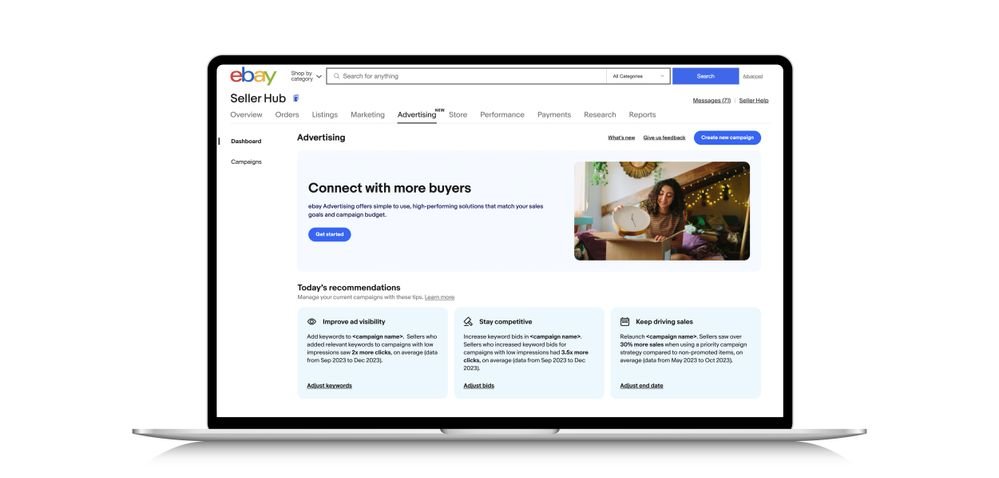
Source: The eBay Community
For instance, eBay Motors offers vendors a user-friendly dashboard where the listing process and performance tracking have been put together in an intuitive interface, enabling sellers to work as efficiently as possible and ultimately satisfy their clients.
Actionable sales insights
Long-term growth for the vendor depends on data-driven decisions. Actionable analytics present clear pictures of business performance and customer behavior to the vendors:
- Vendors can identify high-demand products and optimize their listings for visibility and conversions.
- Sales trend analysis helps vendors refine their strategies, from product descriptions to promotional campaigns.
- Customer behavior insights allow the vendors to tailor offerings to ensure their offerings meet the dynamic needs of the market.
By the way, Amazon's Seller Central grants vendors detailed analytics that help them make strategic adjustments to boost sales and satisfy customers.
Smart pricing tools
Pricing flexibility is an important factor in an auto parts marketplace where competition can get very intense. As:
- Dynamic pricing tools let vendors adjust rates instantly, as market demand, competitor pricing, and stock levels change.
- Automated discounts help liquidate the slow-moving stock and thus guarantee stock turnover with no human intervention.
- Flash sales and time-sensitive promotions can boost sales significantly while also attracting consumers during low-traffic periods.
For example, the popular auto parts marketplace Landberg relies on Prisync to dynamically alter the prices of its stock based on market demand, competitor rates, and stock on hand. This tool automatically applies discounts on slow-moving inventory to help vendors easily maintain stock turnover.
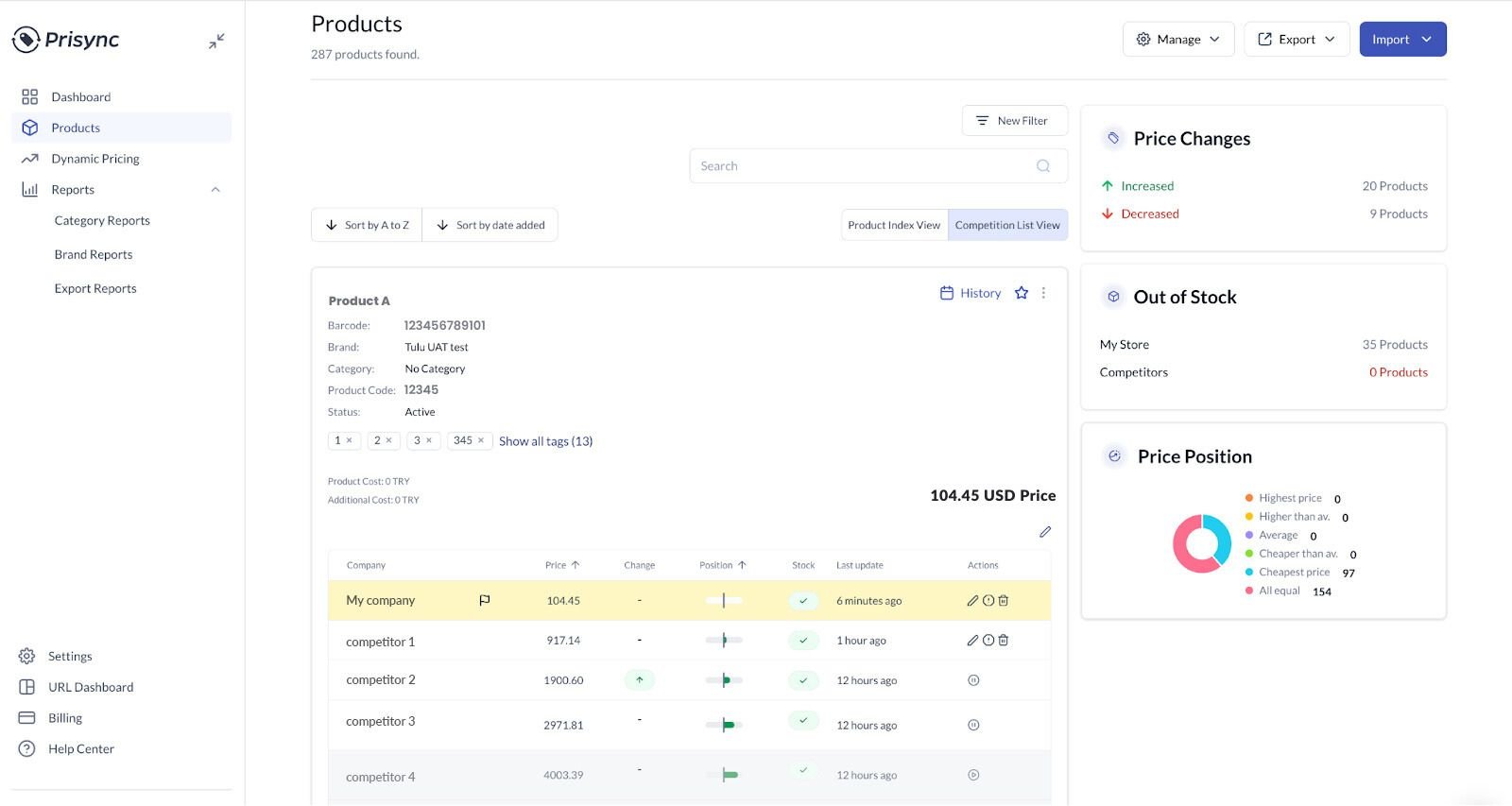
Source: Prisync
Equipped with features like flash sales and time-sensitive promotions, Prisync increases sales up to 20%, thus helping keep vendors competitive and buyers satisfied.

User engagement and experience
Design that keeps users coming back
To convert first-time users into regulars, your marketplace website design must be eye-catching and easy to use.
Mobile-friendly and responsive design
Given that mobile devices account for the lion's share of online traffic, it becomes necessary to make your marketplace mobile-friendly. Key benefits of mobile responsiveness include:
- Convenience for users on the go: allows customers to browse and buy parts anytime, anywhere.
- Improved SEO rankings: search engines prioritize mobile-friendly websites, increasing the visibility of your marketplace.
- Improved UX: engages customers with content, reducing bounce rates.
A mobile-responsive design in ecommerce will ensure that your website performs exemplary on all screens, just like it does on desktops, providing ease of use and all features.
Simple navigation and clear categories
The customer usually comes to a car parts marketplace with a specific part or category in mind. Intuitive navigation and well-organized categories can make their journey easier. Here are the features to consider:
- Clear category hierarchies: products fall into logical categories, such as 'engine parts,' 'suspension,' and 'accessories.'
- Breadcrumb navigation: helps users retrace their steps and move easily between sections.
- Sticky menus: keep navigation options accessible as users scroll.
We’ve already drawn inspiration from the AutoZone website. It is an example of intuitive navigation done right: simple layout, easy to find parts by make, model, year, or type in just a few clicks. This clear search filtering for auto parts ensures that even new visitors can quickly find what they need.
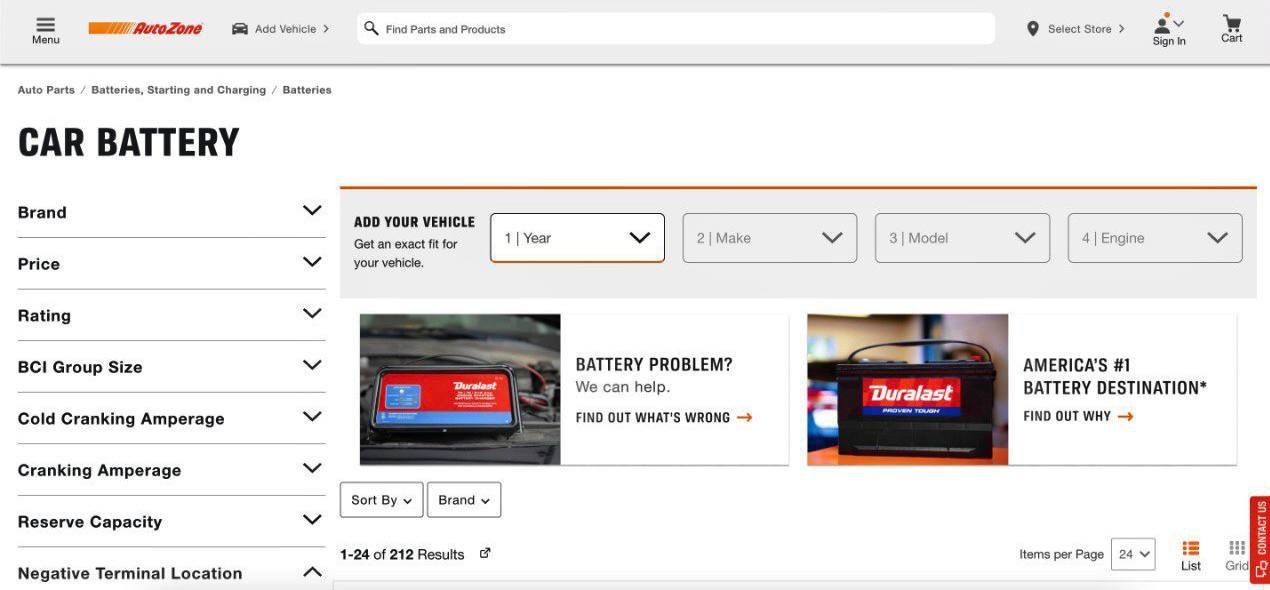
Source: AutoZone
Speed that matches user expectations
A website should load quickly as 53% of mobile visitors will leave a site if it takes longer than three seconds to load, leading to higher bounce rates and lost sales. Even a 0.1 second delay can reduce conversions by up to 7%. Here is what you can do to optimize speed:
- Monitor site performance: this will help you identify and resolve performance issues with tools like Google PageSpeed Insights or GTmetrix.
- Compress images and media: this reduces file size without making images and media quality worse, so they load quicker.
- Optimize code: optimize your code base on a regular basis, update outdated methods, refine your architecture, use regularly updated APIs.
- Leverage lazy loading: a feature that will wait for content that is offscreen until the user scrolls to it.
- Enable Gzip compression: compressing the web files will reduce the time it takes to transfer content between servers and browsers.
- Upgrade server hardware: faster servers or cloud hosting will do a better job, giving more scalability and performance.
Optimizing the speed will go beyond performance: it will also make your customers happier and your marketplace more successful.
Keeping customers happy and engaged
So, why's it important to keep customers happy and engaged? Well, happy customers are the lifeblood of a successful marketplace, especially in the auto parts industry, where buyers rely on your ecommerce marketplace platform to quickly find the exact parts they need. Satisfied customers are more likely to return, leave positive reviews, and recommend your marketplace, which will help you grow.
It's not just about sales, it's about engagement, too. This is where customers trust you to provide them with the right product, technical support, and clearly stated policies. In a competitive market, great support, loyalty rewards, and easy returns will make your marketplace their first choice. Happy customers will make your site their go-to for all their automotive parts needs.
24/7 support when it’s needed
Issues can arise at any time, and immediate customer support in the auto marketplace is essential to keep your clients satisfied. In fact, 90% of consumers expect an immediate response when they reach out for help, according to HubSpot.
Here are the key ways on how you can provide a round-the-clock support:
- Offer live chat for instant assistance with product inquiries, order updates, or technical issues.
- Maintain a detailed and searchable help center with FAQs and tutorials to address common concerns.
- Provide email or phone support for more complex queries, ensuring no customer feels left behind.
So, quick and reliable support reduces frustration and builds confidence in your marketplace.
Customer reviews
For any brand, user reviews and ratings are some of the most credible building blocks you can have.
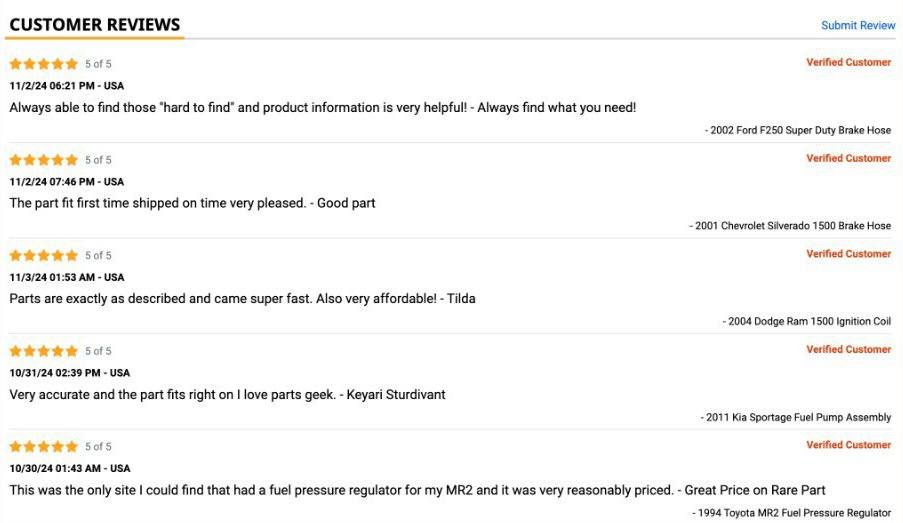
Source: Parts Geek
So, you should:
- Allow customers to rate products and leave detailed feedback to help others make informed decisions.
- Highlight positive reviews to boost product visibility while addressing negative feedback constructively.
- Implement a verification system for reviews to make sure authenticity and trustworthiness.
Customer reviews create transparency, fostering trust among new and returning buyers.
Smooth payment and checkout
A straightforward payment and checkout process is the final step in turning a shopper into a customer and greatly influences their overall satisfaction.
When payments are quick, secure, and hassle-free, customers feel confident and satisfied, increasing the likelihood of repeat purchases. On the other hand, a clunky or confusing process can lead to frustration and abandoned carts.
Let's see how you can make sure your payment system gets it right.
Hassle-free checkout
One of the main reasons people may leave your website without making a purchase is because the checkout process is too long and complicated: 22% of shoppers will just leave their shopping carts.
Here are features you should add:
- Guest checkout: don't make customers create an account, and let customers save their payment information so they don't have to enter it every time.
- Single-page checkout: put all the shipping, payment, and confirmation steps on one page to make the checkout process easier.
- Progress indicators: let them know where they are in the checkout process to maintain expectations and reduce frustration.
If you make checkout easier, you can get rid of the extra friction that makes customers lose interest in their purchases.
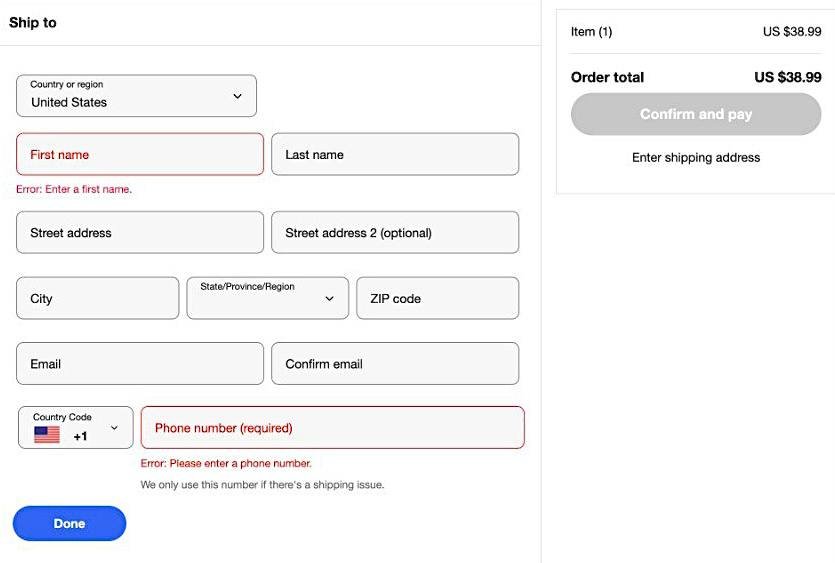
Source: eBay Motors
Flexible payment options
It’s important to provide a selection of payment options to accommodate your customers' diverse preferences.
As Baymard Institute's research reveals, 13% of shoppers look for multiple payment methods at checkout, and the absence of their favorites can lead to cart abandonment.
Here is what you can do to address these expectations:
- Accept credit and debit cards, the most widely used payment method globally.
- Integrate digital wallets like PayPal, Apple Pay, and Google Pay for convenience.
- Include BNPL services, which can boost average order value, as seen in stores generating nearly $280 compared to under $250 without BNPL.
- Provide regional payment methods like bank transfers, cash on delivery, or local e-wallets in specific markets.
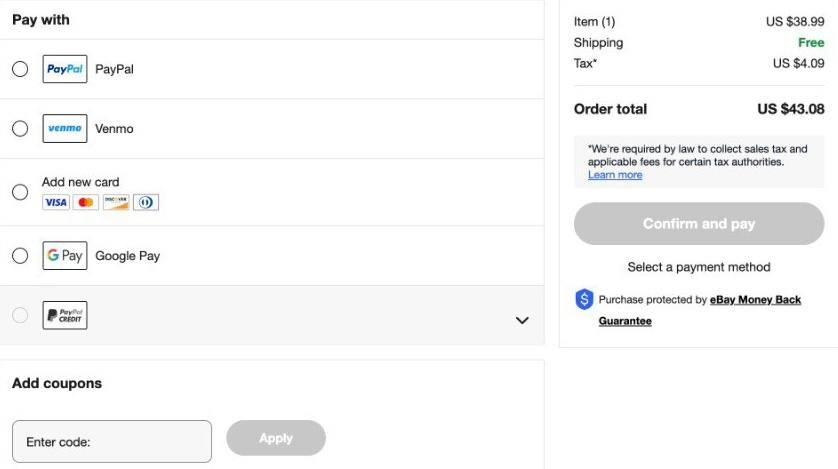
Source: eBay Motors
The more options you will provide to pay for services, the more convenient it will be. And no customer will be left out, thus driving higher conversions and loyalty.
Top-notch security
Shoppers are sometimes worried about security, leading 17% of them to decide not to buy because they're not confident in the website. Where there is a good reputation for safety, it often leads to better retained and happier customers.
Let's focus on customer benefits and practical examples of what you can do and how it will give customers peace of mind.
| What can you do? | Why does it make customers feel safe? | Example in action |
| Use SSL encryption | Keeps their personal and payment details safe from prying eyes. | Lock icon in the browser address bar. |
| Follow PCI DSS standards | Shows you’re serious about protecting their payment info, just like major banks do. | Trusted by major credit card networks. |
| Offer two-factor authentication | Gives them extra peace of mind by adding an extra step to secure their account. | A verification code sent to their phone. |
| Add fraud detection tools | Catches suspicious activity, so they don’t have to worry about stolen details or fake purchases. | Alerts for mismatched billing and shipping. |
| Show trust badges | Reassures them with visible “Secured” icons during checkout—proof you’ve got their back. | “Secured by SSL” or “Verified by Visa” seals. |
| Be transparent about privacy | Builds trust by letting them know exactly how their data is handled—no surprises. | A detailed and easy-to-read privacy policy. |
Marketing and visibility
Attracting users and vendors to your auto parts marketplace requires more than just a great platform - it needs powerful visibility and smart marketing tools to stand out in a crowded space.
Boost search rankings
More than product listings are required to thrive in search results: you need optimized, engaging, and relevant content. Search engines reward those marketplaces that prioritize the user experience, credibility of the website, and responsiveness of mobile.
Here is how to boost your search rankings effectively:
- Listings should be optimized with strategic keywords, meta descriptions, and high-quality images.
- User reviews, technical specifications, and compatibility information should be included in the listing.
- Mobile responsiveness will definitely help to achieve better rankings.
Did you know that the top three results on Google get more than 54.4% of all clicks? The higher you rank, the more users will find and trust your marketplace.
Reconnect with customers
Abandoned carts are not the end: they are opportunities on a platter waiting to be converted into sales. You will be able to recover your lost customers and simultaneously build long-term loyalty with effective personalization and smart strategies for re-engagement.
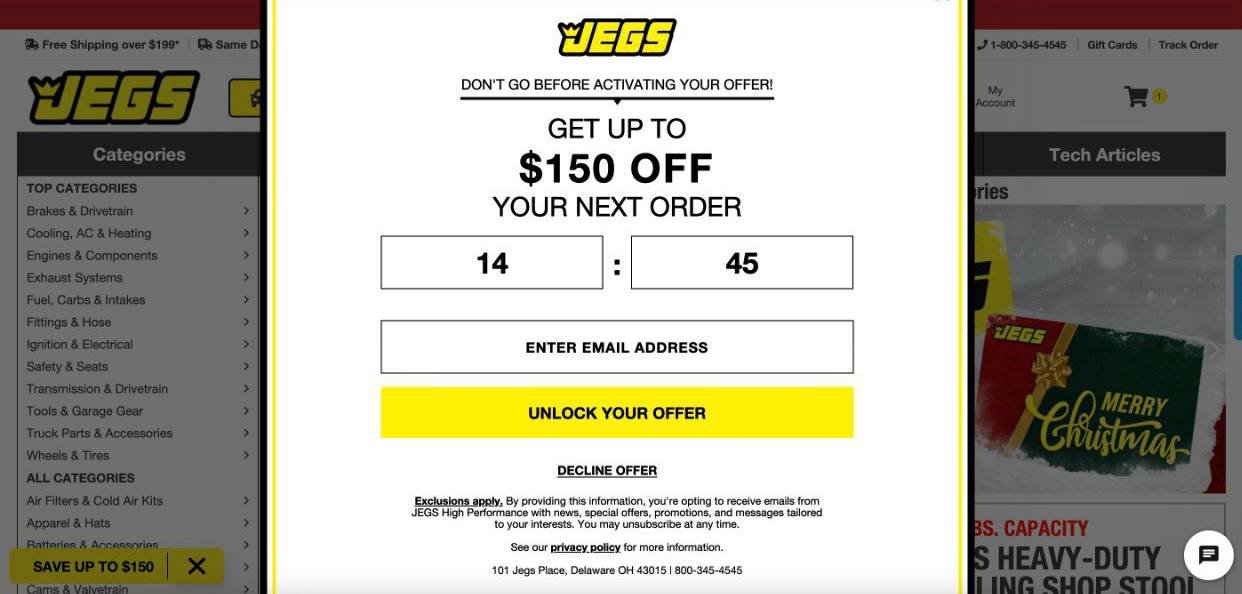
Source: JEGS
Here's how:
- Send personalized email campaigns: remind users about items left in their carts and suggest complementary products. Include discounts or free shipping offers to incentivize them to complete their purchase.
- Run retargeting ads: with dynamic ads, make sure to show customers items that they viewed or abandoned. Highlight benefits like limited stock or time-sensitive deals to show urgency.
- Push notifications: inform users about restocks, price drops, or exclusive offers based on their browsing history and preferences. Push notifications have higher engagement rates compared to emails, ensuring users don't miss out.
- Incentivize completion: offer marginal discounts, loyalty points, or free add-ons for completing the purchase to users.
With these strategies or more, one is surely able to retrieve up to 26% of the abandoned carts, which convert missed opportunities into valuable conversions and foster customer loyalty.
Leverage social media
Social media integration in your marketplace isn't optional anymore: that's where your customers are hanging out. Engaging platforms such as Instagram, Facebook, and TikTok give you the creative license to showcase your products and reach a wider audience.
Here are some key tips to help you get the most out of social media for your marketplace:
- Publish product showcases, how-to videos, and other engaging content.
- Use targeted advertising campaigns to reach specific demographics.
- Encourage user-generated content to build community loyalty.
Social platforms are essential in converting browsers into customers, with 87% of buyers believing social media influences their decisions and companies seeing up to 59% larger deals through social selling strategies.
Promote special offers
The one thing that really drives the customers wild is a deal. Exclusive promotions and time-sensitive discounts may stir urgency and drive them toward an immediate action. Strategic promotions make your marketplace a go-to destination for deals, so:
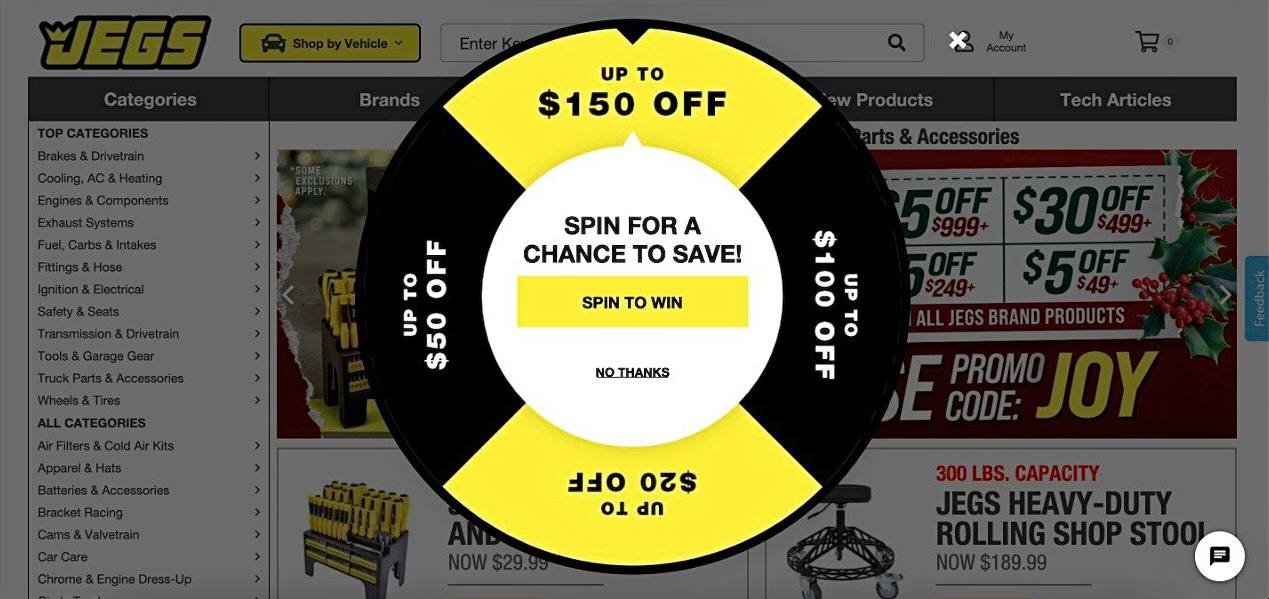
Source: JEGS
- Offer vendor discounts, seasonal sales, and bundle promotions.
- Use countdown timers and bold CTAs to create urgency.
- Highlight time-sensitive deals to engage and convert customers.
Put them all together, and combine SEO, social media engagement and re-engagement techniques and promotions. Thus, you will increase the chances of your marketplace becoming visible and, therefore, growing.
Wrapping up
Simply put, a successful auto parts marketplace is more than just an online platform: it is about creating a frictionless experience for buyers and sellers alike.
Integrate smart tools like compatibility checkers, supplier dashboards, and secure payment options to make it easier for customers to find what they need. Instinctive design backed by seamless functionality builds trust and loyalty among customers and keeps them coming back for more. And in the end, your marketplace will drive sales and set a new standard for the auto parts industry by providing a solution that is both reliable and effective.
At Codica, with over 10 years of experience, we are great at building custom marketplaces for companies like yours. Check out our portfolio of successful platforms we've built to get inspired for your own, future marketplace. Get in touch with us today to make your vision a reality!
